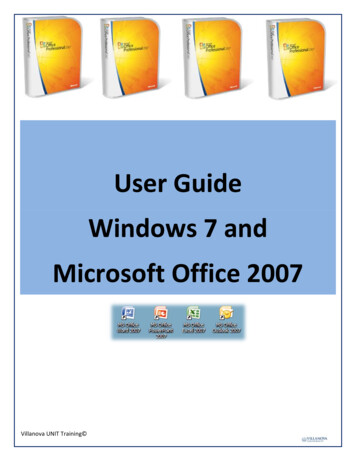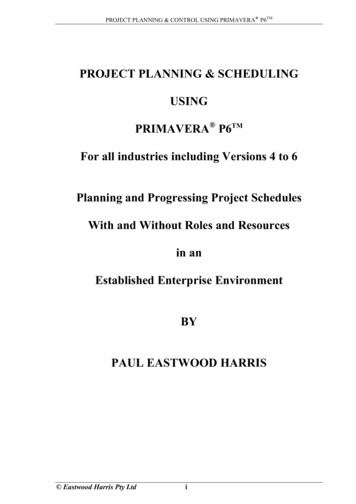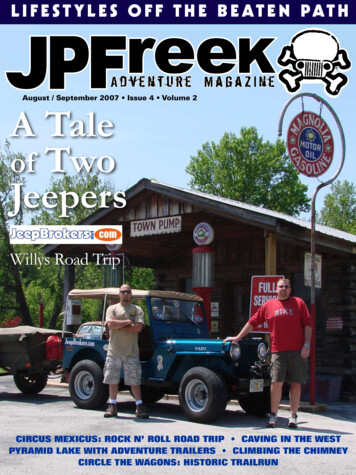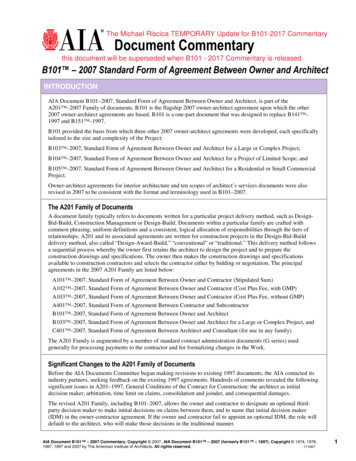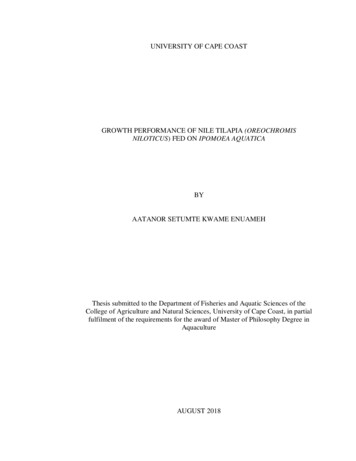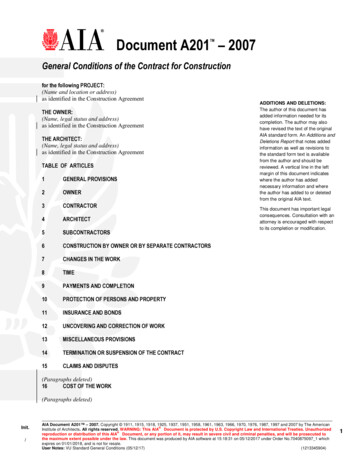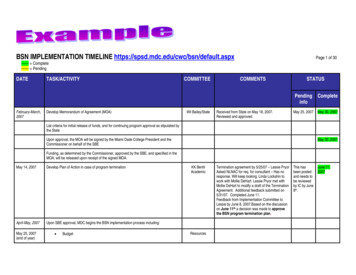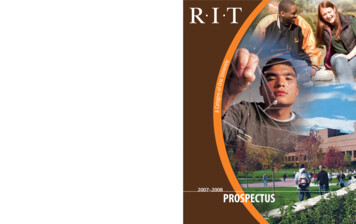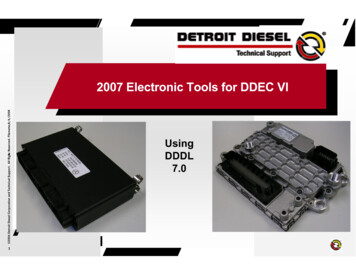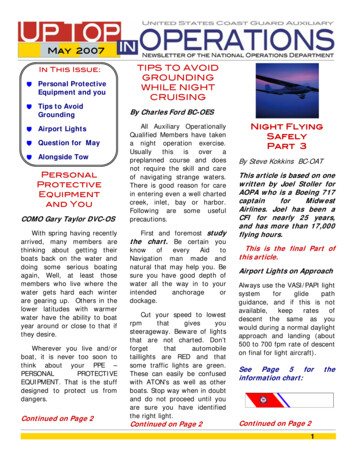
Transcription
AUGUSTMay 2007In This Issue:G Personal ProtectiveEquipment and youG Tips to AvoidGroundingG Airport LightsG Question for MayG Alongside TowPersonalProtectiveEquipmentand YouCOMO Gary Taylor DVC-OSWith spring having recentlyarrived, many members arethinking about getting theirboats back on the water anddoing some serious boatingagain, Well, at least thosemembers who live where thewater gets hard each winterare gearing up. Others in thelower latitudes with warmerwater have the ability to boatyear around or close to that ifthey desire.Wherever you live and/orboat, it is never too soon tothink about your PPE –PERSONALPROTECTIVEEQUIPMENT. That is the stuffdesigned to protect us fromdangers.Continued on Page 25/16/2007JUNE 2005TIPS TO AVOIDGROUNDINGWHILE NIGHTCRUISINGBy Charles Ford BC-OESAll Auxiliary OperationallyQualified Members have takena night operation exercise.Usually this is over apreplanned course and doesnot require the skill and careof navigating strange waters.There is good reason for carein entering even a well chartedcreek, inlet, bay or harbor.Following are some usefulprecautions.First and foremost studythe chart. Be certain youknow of every Aid toNavigation man made andnatural that may help you. Besure you have good depth ofwater all the way in to yourintendedanchorageordockage.Cut your speed to lowestrpmthatgivesyousteerageway. Beware of lightsthat are not charted. Don’tforgetthatautomobiletaillights are RED and thatsome traffic lights are green.These can easily be confusedwith ATON's as well as otherboats. Stop way when in doubtand do not proceed until youare sure you have identifiedthe right light.Continued on Page 2Night FlyingSafelyPart 3By Steve Kokkins BC-OATThis article is based on onewritten by Joel Stoller forAOPA who is a Boeing 717captainforMidwestAirlines. Joel has been aCFI for nearly 25 years,and has more than 17,000flying hours.This is the final Part ofthis article.Airport Lights on ApproachAlways use the VASI/PAPI lightsystemforglidepathguidance, and if this is notavailable,keepratesofdescent the same as youwould during a normal daylightapproach and landing (about500 to 700 fpm rate of descenton final for light aircraft).See Page 5 forinformation chart:Continued on Page 21the
Up Top in OperationsP. P. E. and YouContinued from Page 1In our case, our PPE is mostimportant when one falls intothe water.Let’s look atwhat PPE is required as amember in the boat crewprogram (Crew, Coxswain, andPWC Operator), how to use it,and how to maintain the PPEor at least where to find thatinformation for your own PPE.Depending on where youdo your boating, air and watertemperature will be the mostimportantfactorsindetermining what PPE you arerequired to use.You can find valuableinformation on PPE at:Rescue and Survival SystemsManual (R&SS) COMDTINSTM10470.10, Chapters 3 and IM 1047010F.pdfOperations Policy Manual(OPM) COMDTINST M16798.3,Chapter IM 167983E.pdfRescue and Survival SystemsManual (R&SS) COMDTINSTM10470.10, Chapters 3 and 4:where to find that informationfor your own PPE.Continued on Page 3May 2007TIPS TO AVOIDGROUNDINGContinued from Page 1Use your binoculars, they neednot be night vision type, agood 7 x 50 binocular will helpa lot. Where applicable useyour compass, (of course youplotted your bearings beforehand). A SPOTLIGHT is criticaland a constant watch of yourdepth soundings will save youover and over again. Try toeliminate all lights and glareon foredeck and from all othersources. Remember to keepyour light on the water andout of the eyes of otherboaters.Don’t be afraid to ask forhelp. A radio call on a workingchannel has brought help tome from other boats and onoccasion from a base station.Listen on the working channelfor some operating station. Assoon as he signs-off, call him,he maybe local and haveanswers for you If all ElseFails, drop the anchor whileyou are still in deep water.If possible have a nightexperienced coxswain aboardfor your first night adventure;and when possible make yourfirst attempt on waters you arefamiliar with in the daylight.Number 0507Hank Demler, Editorhwdemler@comcast.netNight FlyingSafelyPart 3Continued from Page 1Approaching your destinationairport, the tower may not beoperating during the nighthours, so you may need toactivate the runway lightingvia the com-radio-controlledpilot controlled lighting (seeAIM Section 2-1-6 for D) and current NOTAMSfor the proper frequency).These systems are installed atmany non-towered airports aswell.If youkeyyourmicrophone seven times withinfive seconds on the designatedfrequency (usually CTAF ortower frequency), the highestintensity available will activate,including VASI/REIL (visualapproach slope indicator /runway end identifier lights),approach lighting, and allrunway and taxiway lights.Five times within five secondsyields medium intensity lights,and three times within fiveseconds activates the lights atlow intensity. Fifteen minutes'lighting duration is nowavailable.Continued on Page 42
Up Top in OperationsR&SS Manual or from theP. P. E. and Youappropriate manufacturer.Continued from Page 2The manufacturer’s website or documentation providedwith the particular equipment.HypothermiaProtection:When hypothermia protectionmust be worn depends onboth the ambient air and watertemperature.The chart onpage 3-6 of the RSS manual(copied on Page five) willdefine what is required andwhen.If both the water and airtemperatures are below 50 , adry suit with appropriateundergarments or the MSD900Breathable Marine SurvivalSystem must be worn. The drysuit has no inherently buoyantso floatation must also beworn with it. The MSD900does not require any additionalflotation.If the air temperature isabove 50 but the watertemperature is between 50 and 60 , the anti-exposurecoveralls shall be worn.If the water temperature is60 degrees, then the Type Ior III PFDs are used with awork uniform or ODUs.Information on proper useandmaintenanceofhypothermiaprotectionequipment can be found in theMay 2007Inherently Buoyant PFDs:All PFDs must be Coast Guardapproved and be InternationalOrange or high visibilityyellow. No other colors areauthorized for obvious reasons(visibility when searching forsomeone in the water).Additionalinformationonmaintaining PFDs can be foundin the RSS Manual in ChapterX as well as the manufacturer.Maintenanceisgenerallylimited to inspection of zippers,straps and overall conditionand cleaning after use.Inflatable PFDs: Must beCoast Guard approved andonly the automatic/manualinflation type is authorized(manual inflation only modelsare not authorized when underorders). Inflatable PFDs mustalso be either internationalorange or high visibility yellow.Never wear anything overan inflatable PFD as theinflation could be restricted orthe wearer could even beinjured.Inflatable PFD bladders candevelop leaks, the bobbinsused to release the CO2 d. Any one of theseconditions can ruin your day!Continued on Page 4DISTRIBUTION:Direct e-mail:National BoardDIRAUXDSOs AN/AV/CM/OP/DFSOBy DIRAUX to:OTOsBy DCOs to:District BoardDCPs to FCsBy DSOs to:SOs and FSOsThe DVCQuestion of theMonthBy Keven Redden, BC-ONB,A certain bridge tenderis in the habit of ignoringsmall boat traffic calls foropeningsandonlyrecognizeslargercommercial traffic.BecauseyouarerecognizedasanAuxiliarist, you have beenapproachedbylocalboaters with complaintsabout this issue. Howwould you respond?Answer on page 63
Up Top in Operationsa PEPIRB if the OPFAC doesP. P. E. and Younot have an installed 406Continued from Page 3EPIRB. Periodic testing andinspectionaredoneinBecause inflatable PFDs areaccordance with the PEPIRBmore susceptible to problemsmanufacturer’sthan inherently buoyant PFDs,recommendations.periodic inspections are amust. Periodic maintenanceitemsinclude;Inspectingand/or replacing the bobbin;Checking the CO2 cylinder thatit has not been pierced;Inflating the PFD and leaving itsit for several hours or evenovernight to check for leaks;Checking the oral inflationvalves for leaks; and, Checkingthestraps,seams,andhardware for rips, tears, orholes as well as cleaning einstructions closely if you useinflatable PFDs.SAR Vest: The orangenylon mesh vest is designed tocarryallyoursurvivalequipment and is worn over allflotationdevicesexceptinflatable PFD’s. For inflatablePFDs without built-in pouches,waist pouches are available tocarryrequiredsurvivalequipment. Maintenance islimitedtocleaningandinspection of hardware.Survival Equipment Required:PEPIRB – At least onemember of the crew on anOPFAC must be equipped withMay 2007Also required are a:PML/Strobe LightSurvival KnifeMirrorWhistleNote: PML – In cold water,the PML (chemical light) hasbeen found to be ineffective.In these areas, a strobe light isrequired.Each piece of survivalequipment must be secured tothe SAR vest (or waist pouch)with 36” piece of type 1 nyloncord using bowline knots (thiswill keep the equipment withyou if you should drop it whilein the water).Please take the time toreview the R&SS Manual andthemanufacturer’srecommendations to keep yourPPE in top notch condition.Remember, it could save yourlife, but only if it is properlyworn and maintained!Night FlyingSafelyPart 3Continued from Page 2Approach lights often theprimary instrument runway.Theairportrotatingbeacons for civilian usealternate white and green. Thegreen flash often appearsmuch dimmer than the white.Don't confuse this with amilitary airport beacon thatalternates white, white, andgreen, such as USCG AirStations. Also, be familiar withanylow-altitudemilitaryoperations areas along yourroute, which can extend overwater.Another classic "trap" duringnight cross-country flightsoccurs when there are twoairportsrelativelynearby(within 20 NM of each other)that have similarly configuredrunways. Many pilots havelined up perfectly for astraight-in approach to oneairport's runwayonly torealize that what really liesahead is another urse, while talking to thetower operator at airport #1).Even professional pilots havemade this mistake. Usestandardtechniquewhenapproaching an uncontrolledairport at night, circling 1,500feet above field elevation toview the lighted wind tee orContinued on Page 64
Up Top in OperationsVASI/PAPI light system for glide path guidanceBELOW Glide PathON Glide PathABOVE Glide PathVASI (2-bars)Red over redRed over whiteWhite over whitePAPI (4 lights)All redTwo white-two redAll whiteAlongside TowBy Hank Demler BC-OEEI have seen many versionsof this task over the past 16years as a QE, some wereeven correct. It seems everymentor has their own idea ofhow to perform this task.There are of course manyreasonstomodifytheprocedure depending upon thetowing vessel and the vessel tobe towed, not to mention theusual variables such as wind,current,waterdepth,maneuveringroomanddocking conditions. Note I didnot say Sea state as any thingbut calm waters is high on theRisk Assessment scale, usuallythe only acceptable sea stateis calm (less than 2ft Seas);Unless you happen to bedriving a CG "41 Footer".Chapter 17 of the BoatCrewSeamanshipManualCMDTINST 16114.5C Rev.Sept 16, 2003. "TowingAlongside",Page17-54."When set up properly, analongside tow allows twovessels to be maneuvered asMay 2007one". It is not my Intention tooutlinethesectiononalongside towing but I wouldrecommend that all coxswainsreview Pages 17-54 to 17-57as well as the General Towingprecautions on 17-58 to 17-60.Of the many tasks thatmay be required in theprosecution of a Safety Patrol,Towingespeciallythealongside towing is a study in"Team Coordination Training",as well as Risk Assessmentand Management. While it isnecessary for the Coxswain toconduct the proceedings, awell trained crew familiar withthe Auxiliary Patrol Vessel, willbeagreathelpinaccomplishing the missionsafely. An imperative is to briefthe crew to exactly what isplanned, and get commentsandagreementontheproposed action. Every oneshould know what is expectedof them.A major problem isdetermining how the two hullswill align alongside. If the hullmatch is not good damagemay well occur to bothvessels, or even worse tomembers of the crew. If agood hull match is notpossible, one should think ofpossible alternatives, or evenbetter get another Auxiliaryvessel to take the tow.Before taking a vessel inalongside Tow, be sure youhaveconsideredallthefactors. Above all be sure thevessel you are about to securetightly to your boat is notsinking. Remember in orderto give you the best chance tomaneuver, the towed boatstern, rudder or drive needs tobe forward of your stern,rudder or drive.Currently this task isrequired every three years, butregular practice is helpful.Planning ahead is always agood idea and additional cleatswith backing plates will giveyou more tie up options. Largefenders are always good tohave.One other notealthough all crew members willbe working to hook up thetow, the requirement tomaintain a proper lookout isnot to be forgotten."Situational Awareness"5
Up Top in OperationsNight FlyingSafelyPart 3Continued from Page 4windsock, before entering thepattern.The current A/FD lists all ofthese important details aboutwhat is available at destinationairportsthatyoumustincorporate into your preflightplanning. Note some fieldspublish higher pattern altitudesfor turbine aircraft.In closing, the basic flyingtechniques and procedures forday and night flying areessentially the same, just moreso. Flying fundamentals neverchange. Your airplane doesn'tknow whether the moon is outor not, but the stage on whichyou are performing has adefinite new look at night.Practice with your crew, andbuild confidence!Answers toDVC-ON QuizTheAuxiliaristshoulddocument the event or events(Date, time, vessel involved)and forward the information asa Bridge Discrepancy reportaccording to their Districtreporting Procedures.May 2007approaching vessels.RequirementsThe regulation signs mustsummarize the regulations,and if advance notice isrequired to open the draw, thesigns shall state the name,address,andtelephonenumber of the person(s) to benotified. 33 CFR 117.56A Drawbridge must:1.Open promptly and fullyfor vessel passage uponrequest except when specialregulations are listed inSubpart B of 33 CFR ons are required topost signs on both sides of thebridge which are of sufficientsize and be so located as to beeasily read at any time byUS Coast Guard AuxiliaryOperationsContact rtment ChiefDavid A. ElliotDC-O@cgaux.usDeputyChiefRobert T. ShaferDC-Od@cgaux.usAids to NavigationFrank J. Larkinfrankjlarkin@verizon.netAviationByron A. Moebyronmoe@comcast.netCommunicationsWilliam H. Scholzw1hijcw@aol.comSurface OperationsGary A. Taylorgtaylor@alaska.netEducationBruce C. PughDVC OE@yahoo.comCG-3PCXOperationsDivision ChiefLCDR Kathryn C. Dunbar,USCGKathryn.C.Dunbar@uscg.milCG-3PCX Aviation andRecreationalBoatingSafety Branch ChiefLTJG Shannon F erations Branch ChiefCPO ,6
PERSONAL PROTECTIVE EQUIPMENT. That is the stuff designed to protect us from dangers. Continued on Page 2 TIPS TO AVOID GROUNDING WHILE NIGHT CRUISING By Charles Ford BC-OES All Auxiliary Operationally Qualified Members have taken a night operation exercise. Usually this is over a
